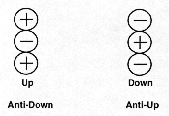
THE NATURE OF MATTER
PHYSICS
MYSTERIES
EXPLAINED
THE NATURE OF FRACTIONAL CHARGE
CHAPTER
4
Section 1 Triplet Substructure of Quarks
Section 2 Quark Charged Matter Accounting
TRIPLET SUBSTRUCTURE OF QUARKS
SECTION
1
The Unit Particle of Matter Substructure
Theory, and the subsequent distinction between matter and energy as components
of Standard Model particles, were first realized by following the math of fractional
charge and putting it together with the tripolar nature of the strong force.
The hypothesis that quarks might have a triplet group of unit charge particles as
a substructure followed directly from the fractional charge math of quarks and from
fractions being ratios of whole numbers.
There was a philosophical belief that fractional charge on a fundamental particle
is impossible.
|
Matter |
Anti-Matter |
|
|
up = +2/3 |
anti-up = -2/3 |
|
|
down = -1/3 |
anti-down = +1/3 |
By definition, a fundamental charged particle must represent the unit charge.
Since quarks were determined to have fractional charge characteristics, it followed
that quarks must not be fundamental charged particles and that quarks must be, at
the minimum, formed from groups of unit charge particles.
The fractional electrical charge mathematics of quarks signaled that quarks had a
composite structure with the quarks made from more fundamental unit charge particle
components, which when taken as a group accounted for the fractional charge mathematics.

The triplet substructure of quarks is dictated by the fractional charge mathematics.
It was determined that quark fractional math could easily be explained by unit particles
of matter composing the quark substructure.
The explanation of how the triplet unit substructure can explain quark fractional
charge math is covered in the next section.
QUARK CHARGED MATTER ACCOUNTING
SECTION 2
Each method of Quark Charged Matter Accounting consists of two ratios, positive matter
ratios and negative matter ratios.
Positive matter ratios, or 'Normal Matter Accounting', is the method presently employed
in physics to calculate the electrical charge a quarks if the quark is a normal matter
quark. If the quark is an anti-matter quark, then 'Negative Matter Accounting' or
negative matter ratios is the method presently employed to calculate the charge of
the anti-quarks.
The other half of each method, which is not presently exploited in modern physical
theory, is in the grayed right side columns in Table 3 and in Table 4 . The same
ratios are in both tables, just different ratios are used in each table.
Quark Charged Matter Accounting
|
Normal Matter Accounting |
Anti-Matter Accounting |
|||
| Positive Matter Ratios | Negative Matter Ratios | Negative Matter Ratios | Positive Matter Ratios | |
|
up = +2/3 |
up = +1/3 |
anti-up = -2/3 |
anti-up = -1/3 |
|
|
down = -1/3 |
down = -2/3 |
anti-down = +1/3 |
anti-down = +2/3 |
|
Think you understand the Unit Matter Substructure
Theory?
Think you understand the Background of Matter Theory?
Comments welcome: jrees@starlight-pub.com
Last Update April 19, 2000
Copyright © 2000 Starlight Publishing Company Hermosa Beach, CA